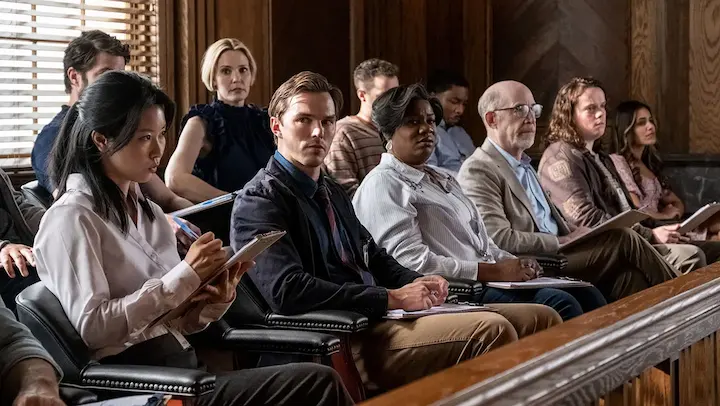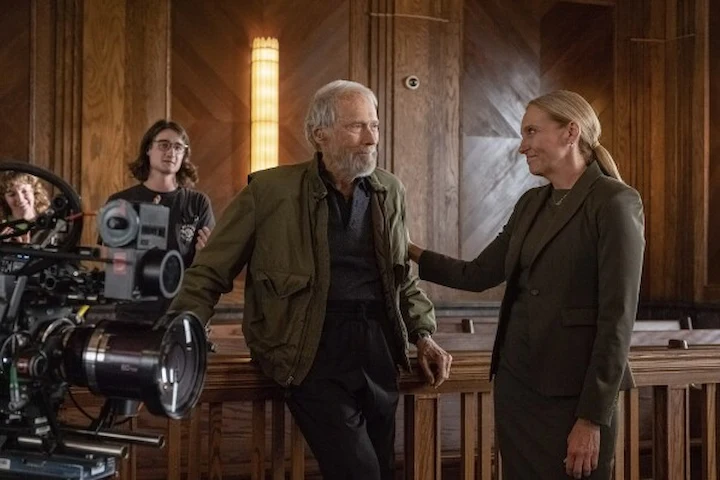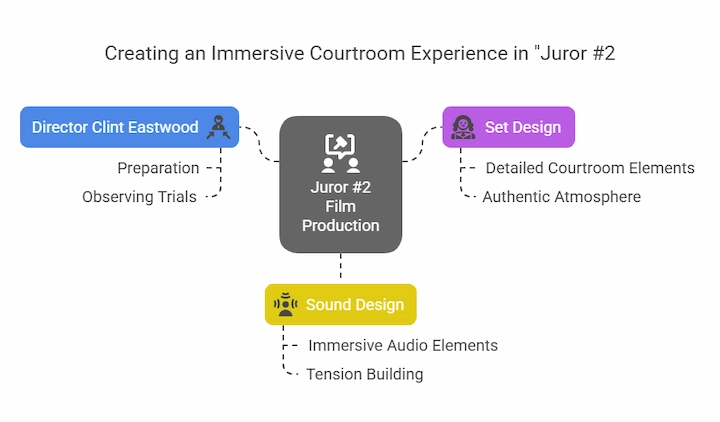Juror #2 Release Date, Storyline, and Everything You Need To Know
The man being tried for murder in Clint Eastwood’s courtroom drama “Juror #2” is convincingly guilty, but as the other man serving on the jury has by the end of the film learned, he feels responsible for the crime he’s meant to adjudicate. Nicholas Hoult plays Justin Kemp, a family man whose conscience is tested after evidence introduced in the trial suggests that he may be linked to the crime.
As the case continues, Kemp must decide whether to play to the jury to save his skin or uphold justice, even at considerable personal cost. This taut legal thriller wrestles with issues of truth, ethics, and responsibility in the American justice system, all captured through Eastwood’s restrained yet powerful direction and storytelling.
Juror #2 Release Date
The team behind “Juror #2” consisted of an incredible ensemble of filmmakers committed to creating a genuine courtroom experience. The ever-preparatory director, Clint Eastwood, crafted a space where you could be a part of the judicial system. The film’s crew spent weeks observing actual trials so they could capture the nuances of courtroom procedures.
The set designers recreated a courtroom with stunning accuracy, from the polished wooden benches to the judge’s imposing bench. Every detail—from the legal documents placed carefully on lecterns to subtle lighting illuminating printable chunks of testimony—was considered with care. The production team wanted the viewers to feel as though they were sitting in the jury box with the characters.
One of the film’s most effective tension-building devices is sound design. The soft click of a pencil during deliberations, the whispers between attorneys, and the heavy bang of the gavel are all immersive experiences. These audio elements give the viewer an understanding of the pressure that jurors are under when making life-changing decisions.
Juror #2 Cast and Character List
| Actor | Role | Description |
|---|---|---|
| Nicholas Hoult | Justin Kemp | A juror who realizes he may be involved in the case he is deliberating. |
| Toni Collette | Faith Killebrew | The determined assistant district attorney prosecuted the case. |
| J.K. Simmons | Harold | A former homicide detective and fellow juror. |
| Chris Messina | Eric Resnick | The public defender representing the accused. |
| Gabriel Basso | James Michael Sythe | The defendant in the trial. |
| Zoey Deutch | Allison Crewson | Justin Kemp’s wife, a schoolteacher. |
| Kiefer Sutherland | Larry Lasker | A lawyer and Justin’s Alcoholics Anonymous sponsor. |
| Cedric Yarbrough | Marcus | A fellow juror. |
| Leslie Bibb | Denice Aldworth | The jury foreperson. |
| Amy Aquino | Judge Thelma Hollub | The judge presiding over the case. |
| Adrienne C. Moore | TBA | Another juror. |
| Francesca Eastwood | TBA | Undisclosed role. |
| Chikako Fukuyama | TBA | Undisclosed role. |
| Onix Serrano | TBA | Undisclosed role. |
Juror #2 Storyline
“Juror #2” takes place in a small town in Georgia and centers on Justin Kemp, a recovering alcoholic who has put his life back together as a family man and respected community member. Called for jury duty in a sensational murder, Kemp initially greets his civic duty with reluctance but takes it seriously. The defendant is charged with killing a young woman in a hit-and-run on a country road.
As the prosecution shows the evidence, including the timeline and location of the accident, Kemp makes a horrifying connection: He was driving on that same road, after drinking several beverages, the night in question. Laps in his memory from that night, which he and those who thought him guilty attributed to his drinking, take on sinister meanings. He starts to wonder if, not the defendant, he might have been responsible for the woman’s death.
A tense psychological odyssey ensues in which Kemp confronts an impossible moral quandary. During the jury’s deliberations, he quietly seeks to persuade his fellow jurors toward a not-guilty verdict while hiding his bias behind the facade of an indifferent juror. His legal, ethical obligation to recuse himself stands in direct contrast to that instinct to preserve himself and protect his family from the repercussions of the crime he may have committed.
As the deliberations become more heated, Kemp discovers new evidence that complicates his understanding of what happened that fateful night. The story weaves together courtroom procedural elements with a look into Kemp’s psyche, leading to a climax that compels him to decide between saving himself or performing an act of justice. The film’s conclusion doesn’t offer easy answers but instead asks audiences to consider what they would do in Kemp’s shoes.
Juror #2: Critical Reception
The film was well-received by critics, who lauded “Juror #2” for its tense atmosphere and thought-provoking themes. Many reviews note that the film generates suspense not by action sequences but moral quandaries that lack easy resolutions. The New York Times described it as “a masterclass building tension through ethical dilemmas.”
Civic duty and personal responsibility resonate with audiences in a way they might not have before, as the film grapples with these ideas. Audiences often leave theaters talking about what they would do in similar situations. That engagement demonstrates the film’s success in making abstract legal concepts feel personally relevant.
Some critics have pointed out similarities between “Juror #2” and classic courtroom dramas such as “12 Angry Men.” But they say this new movie speaks to contemporary worries about bias in the justice system. Updating these themes for a modern audience makes “Juror #2” feel timely and timeless.
The performances have gotten particular attention, with the lead actor praised for conveying complex emotions with little to no dialogue. The cast of dozens creating the jury has been commended for demonstrating how twelve strangers coalesce into an ad hoc community with its dynamics and stresses.
Effect of Jury Service on Public Perception
Read more: ‘Juror #2’ rekindles interest in the jury system, vital in democratic societies. Court administrators in multiple states have informed me that response rates to jury summonses have improved ever since the film was released. This indicates that the movie has made jury service less of an inconvenience and more of a meaningful civic responsibility for those who had never given it a moment’s thought before.
Legal education initiatives have employed clips from the film to clarify the duties of would-be jurors. By highlighting the difficulties and importance of jury duty, these efforts hope to produce more engaged and deliberative jurors. Law schools have used the film as a springboard for legal ethics and jury psychology discussions.
The film has spawned public forums where judges, lawyers, and past jurors discuss what it’s really like to serve on a jury. Such conversations help reconcile Hollywood portrayals with real-life courtroom experiences. They also allow citizens to ask questions about a process many have described as mysterious.
Social media conversations around “Juror #2” often include people discussing their own jury experiences. These personal narratives serve to humanize the legal system and illustrate how everyday people do their part to achieve justice. The film serves as a touchstone for anyone trying to explain what jury service looks like—“The best darn jury service ever,” as one of the film’s taglines puts it.
Where To Watch Juror #2
Juror #2 is streaming on several services, including Amazon Prime Video and Apple TV+, and can be rented for $19.99 or purchased for $24.99. It is available for HBO Max subscribers as part of their subscription without additional charges, and 4 K UHD and HDR are available on compatible devices.
Physical copies of the film are available on Blu-ray and DVD now, including special editions with behind-the-scenes material and commentary from director Clint Eastwood and the cast. Also, select theaters host limited revival screenings of the film, allowing audiences to watch it on the big screen.
FAQ
Is “Juror #2” a true story?
Although “Juror #2” is inspired by real legal cases, the story and characters are fictional. The filmmakers extensively researched the experiences of actual juries to depict an authentic version of the justice system. Still, the central moral dilemma was explicitly concocted for this story.
What is the age rating for “Juror #2”?
The film is rated PG-13 for thematic elements involving serious crimes, some tense courtroom confrontations, and brief strong language. It treats the subject without graphic depictions, making it suitable for mature teenagers and adults seeking legal dramas.
How long did it take to shoot “Juror #2”?
Juror #2 was shot over roughly eight weeks. “Most of this time is spent inside a single courtroom set with production working to document the shifting dynamics of jurors as the trial moved forward,” Craig said. The closed environment made for an electrifying energy while filming and beyond.
Will there be a follow-up to “Juror #2”?
As of now, there has been no official word on a second movie. The movie itself has a full story with final closure. At the same time, the success of the film has spurred conversations about other projects that examine different parts of the justice system through the perspectives of various players.
What sets “Juror #2” apart from other courtroom dramas?
Unlike so many legal thrillers that spotlight attorneys or judges, “Juror #2” revolves around ordinary citizens. This camera and the perspective offered help viewers better comprehend how the justice system is dependent upon regular folks making hard choices. The film also raises ethical questions often not explored in similar movies.
Final Thoughts
Juror #2 is a clarion reminder that our justice system relies on the conscience and judgment of everyday people. By looking at the jury process unfairly and relatably, the movie encourages viewers to think about what they would do when their knowledge and public duty are at odds. As courtroom dramas go, it makes an imprint for its tension and the pressing questions it raises about truth, justice, and moral responsibility in a complicated world.
Table of Contents



